About mCDR and mSRM
Efforts to mitigate the impacts of climate change are gaining interest both in the United States and internationally. Ocean-based climate mitigation techniques may have the potential to alleviate certain impacts of climate change by reducing warming of the earth's surface or by removing carbon dioxide from the atmosphere and storing it for long periods of time in the ocean. Federal agencies, academics, industry, nonprofits and other entities are researching ocean-based climate mitigation techniques such as marine carbon dioxide removal (mCDR) and marine solar radiation management (mSRM).
As a relatively new field of research, there is uncertainty about the efficacy and potential environmental impacts of these techniques. Proposed mCDR and mSRM activities should be carefully evaluated to avoid unintended and significant adverse impacts to human health or the marine environment.
On this page:
- What Are mCDR and mSRM?
- Marine Carbon Dioxide Removal (mCDR)
- Marine Solar Radiation Management (mSRM)
What Are mCDR and mSRM?
Two categories of ocean-based climate mitigation techniques are discussed on this page:
- Marine carbon dioxide removal (mCDR) is an ocean-based process or technique designed to remove carbon dioxide from the atmosphere and store it for long periods of time in the ocean. Examples of mCDR techniques include adding alkaline materials to the ocean to increase the amount of carbon stored in ocean waters; adding iron or other nutrients to ocean waters to increase phytoplankton growth and export of carbon to the deep ocean; and sinking organic materials, such as kelp or crop residue, into the deep ocean.
- Marine solar radiation management (mSRM) is an ocean-based process or technique designed to limit the warming of Earth's surface. mSRM does not remove excess carbon dioxide from the atmosphere. Proposed mSRM techniques involve adding materials to ocean waters, sea ice or the lower atmosphere to increase the amount of solar radiation (e.g., heat) reflected from the ocean's surface to limit surface warming or sea ice melt.

Marine Carbon Dioxide Removal (mCDR)
Ocean Alkalinity Enhancement
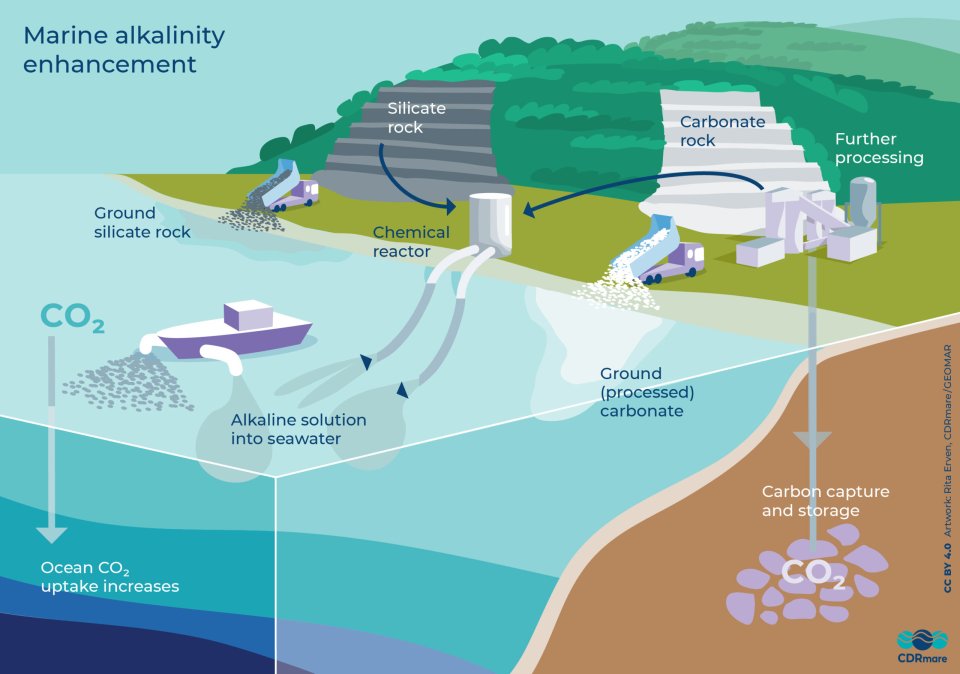
Ocean alkalinity enhancement (OAE) refers to a variety of approaches that aim to remove carbon dioxide from the atmosphere and store it for long periods of time in ocean water, primarily in the form of bicarbonate ions, which is a major component of ocean alkalinity. OAE may also provide the co-benefit of mitigating local ocean acidification.
Several different methods of OAE are being explored, including:
- Adding alkaline and/or basic solutions directly into ocean waters. Basic solutions could be created by electrochemical methods that use electricity to split seawater into its acidic and basic components.
- Adding certain types of mined alkaline minerals to ocean waters.
Potential marine environmental impacts of this approach include:
- Toxic effects on marine organisms from exposure to trace metals contained in alkaline minerals or from interacting with mineral particulates in the water.
- Changes in ocean biogeochemical cycling or ecological communities due to localized peaks in alkalinity or seawater pH.
- Introduction of nutrients such as silicate or iron that may have an ocean fertilization effect.
Ocean Fertilization
Marine plants such as phytoplankton use carbon dioxide from their environment during photosynthesis. Ocean fertilization activities aim to increase the growth of phytoplankton in the ocean (i.e., enhance ocean primary productivity) for the purpose of increasing carbon export to the deep ocean or other uses, such as enhancing fishery productivity. Ocean fertilization does not include conventional aquaculture, mariculture or the creation of artificial reefs.
Increasing phytoplankton growth could be accomplished by adding nutrients (such as iron) to the open ocean to create a phytoplankton (e.g., algae) bloom.
Nutrients for ocean fertilization could be added in the form of a liquid or solid material, or nutrients may be moved from the deep ocean to the surface ocean through a process called "artificial upwelling."
For ocean fertilization to mitigate climate change, three processes would need to occur:
- Ocean fertilization must lead to increased growth of phytoplankton, consolidating carbon and nutrients together into organic material.
- Organic material from the phytoplankton bloom must be transferred into the deep ocean so that it does not simply get recycled near the surface, releasing its captured carbon back to the atmosphere.
- This transfer of carbon from the surface ocean to the deep ocean must result in a subsequent transfer of carbon from the atmosphere into the surface ocean.
Potential marine environmental impacts of this approach include:
- Growth of toxin-producing algae (i.e., harmful algal blooms).
- Deep ocean deoxygenation from biomass decomposition.
- Decreases in ocean productivity in adjacent areas of the ocean, also known as "nutrient robbing."
- Increases in oceanic production of greenhouse gases (methane, nitrous oxide).
- Changes to ecosystem structure and function.
- Acidification of the deep ocean.
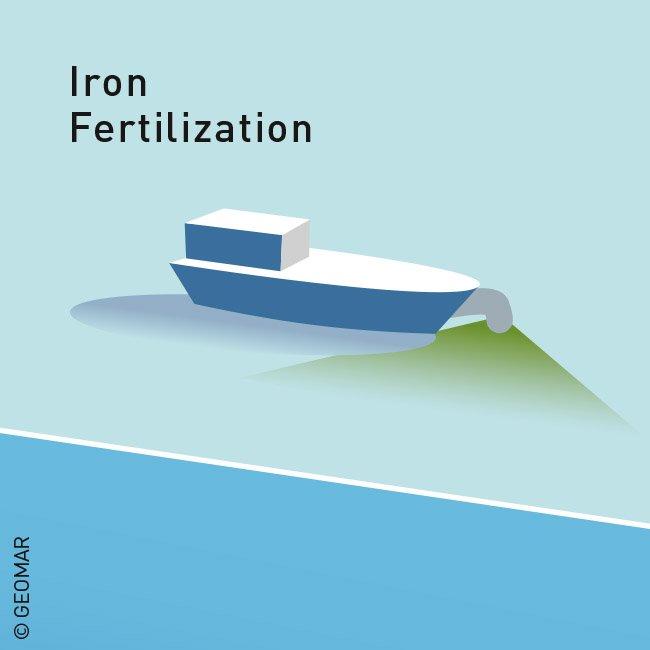
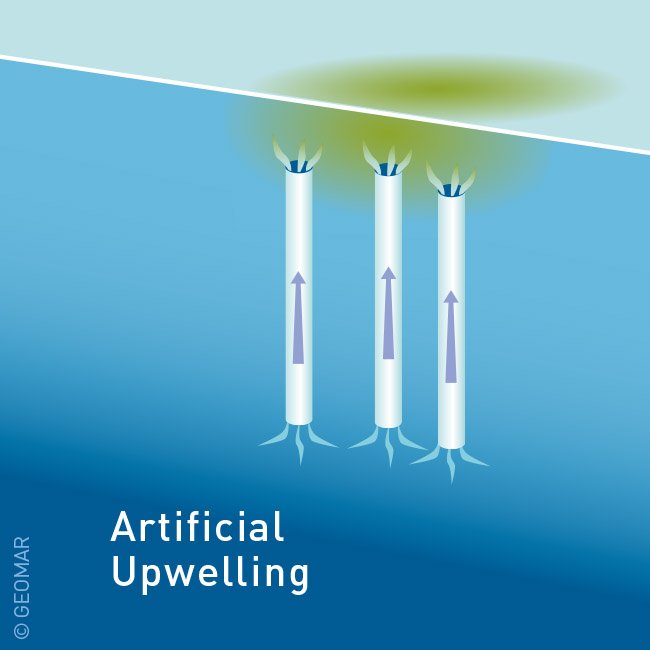
Deep Ocean Biomass Sinking
Plants on land and in the ocean pull in carbon dioxide from their environment during photosynthesis. The carbon contained in terrestrial or marine biomass, such as crops or macroalgae, could potentially be sequestered from the atmosphere for long periods of time by sinking it in the deep ocean.
Potential marine environmental impacts of this approach include:
- Smothering of organisms on the seafloor.
- Acidifying the deep ocean as the biomass is broken down.
- Altering nutrient balances in the deep ocean.
- Other impacts to sensitive deep ocean ecosystems.
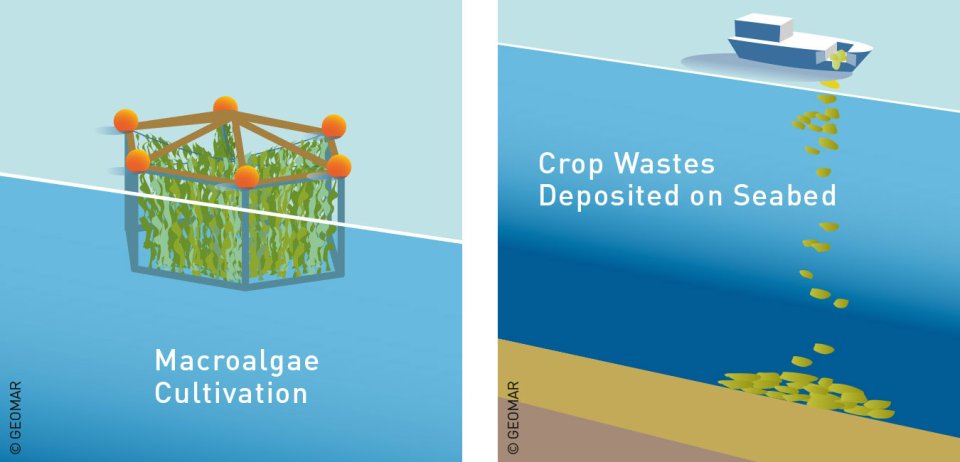
Marine Solar Radiation Management (mSRM)
mSRM includes ocean-based techniques that decrease the amount of solar radiation (e.g., heat) that reaches the Earth's surface. These techniques do not remove carbon dioxide from the atmosphere but instead aim to limit the warming of the ocean from sunlight.
mSRM techniques being explored include:
- Introducing reflective materials (e.g., engineered particles, reflective bubbles, or foams) to sea ice or the ocean surface to increase the amount of sunlight reflected from the ocean's surface and/or limit sea ice melt.
- Adding particles to the lower marine atmosphere to increase the density of clouds and help increase the amount of reflected solar radiation (i.e., marine cloud brightening).
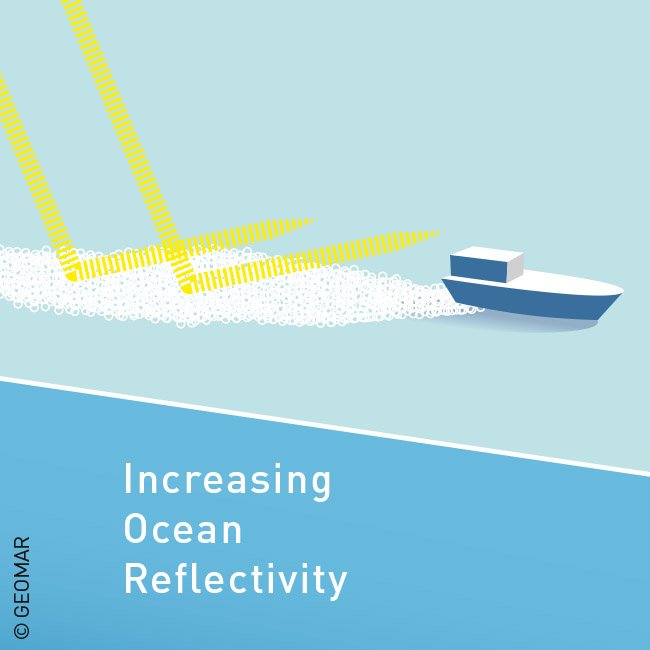
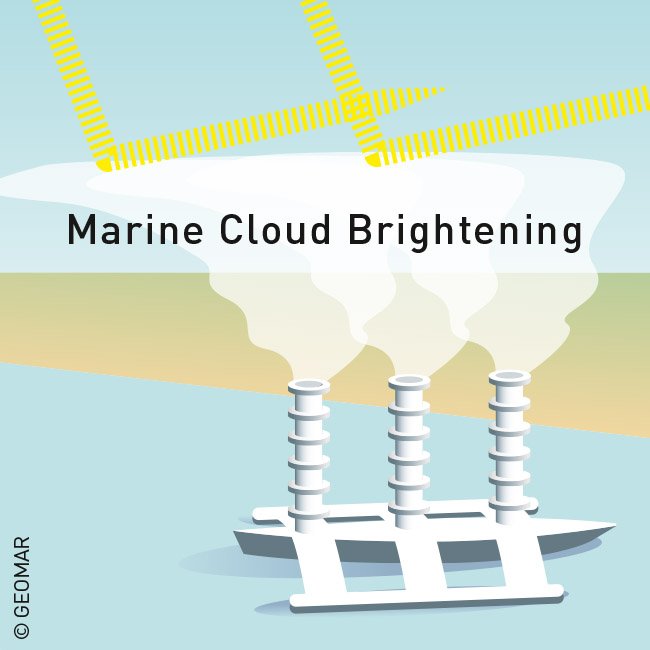
Potential marine environmental impacts of these approaches include:
- Toxicity of introduced materials to marine organisms.
- Decreased ecosystem productivity due to decreased sunlight (i.e., energy) reaching the environment.
- Other impacts depending on the specific materials or methods used and the scale of the activities, including impacts that may occur outside of the immediate geographic area where the activities are conducted.
